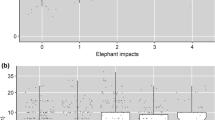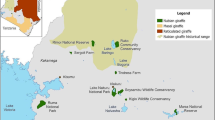Abstract
The iconic giraffe, an ecologically important browser, has shown a substantial decline in numbers across Africa since the 1990s. In Serengeti National Park, Tanzania, giraffes reached densities of 1.5–2.6 individuals km−2 in the 1970s coincident with a pulse of Acacia tree recruitment. However, despite continued increases in woody cover between the 1980s and the 2000s, giraffe recruitment and survival rates have declined and density has dropped to only 0.3–0.4 giraffes km−2. We used a decision table to investigate how four extrinsic factors may have contributed to these declines: food supply, predation, parasites, and poaching, which have all been previously shown to limit Serengeti ungulate populations. Lower recruitment likely resulted from a reduction in diet quality, owing to the replacement of preferred trees with unpalatable species, while decreased adult survival resulted from illegal harvesting, which appears to have had a greater impact on giraffe populations bordering the western and northern Serengeti. The Serengeti giraffe population will likely persist at low-to-moderate densities until palatable tree species regain their former abundance. Leslie matrix models suggest that park managers should meanwhile redouble their efforts to reduce poaching, thereby improving adult survival.




Similar content being viewed by others

References
Arusha Times Reporter (2004) Giraffe brains sold as HIV-AIDS cure hoax. The Arusha Times. Retrieved from http://www.arushatimes.co.tz. 4–10 Sept 2004
Bolger DT, Morrison TA, Vance B, Lee D, Farid H (2012) A computer-assisted system for photographic markrecapture analysis. Methods Ecol Evol 3:813–822
Burnham KP, Anderson DR (2002) Model selection and multimodel inference: a practical information-theoretic approach, 2nd edn. Springer, New York
Campbell K, Borner M (1995) Population trends and distribution of Serengeti herbivores: implications for management. In: Sinclair ARE, Arcese P (eds) Serengeti II: dynamics, management, and conservation of an ecosystem. University of Chicago Press, Chicago, pp 117–145
Caswell H (2001) Matrix population models. Construction, analysis and interpretation. Sinauer, Sunderland
Dublin HT, Sinclair ARE, McGlade J (1990) Elephants and fire as causes of multiple stable states in the Serengeti-Mara woodlands. J Anim Ecol 59:1147–1164
Fennessy J (2004) Ecology of the desert-dwelling giraffe Giraffa camelopardalis angolensis in Northwestern Namibia. PhD thesis, University of Sydney, Sydney
Fennessy J, Brown D (2010) Giraffa camelopardalis. In: IUCN 2013. IUCN Red List of Threatened Species. Version 2013.2. <www.iucnredlist.org>. 27 Nov 2013
Foster JB (1966) The giraffe of Nairobi National Park: home range, sex ratios, the herd, and food. East African Wildl J 4:139–148
Foster JB, Dagg AI (1972) Notes on the biology of the giraffe. Afr J Ecol 10:1–16
Georgiadis N (1988) Efficiency of snaring the Serengeti migratory wildebeest. Report deposited with the Serengeti Wildlife Research Institute, Serengeti
Ginsberg JR, Milner-Gulland EJ (1994) Sex-biased harvesting and population dynamics in ungulates: implications for conservation and sustainable use. Conserv Biol 8:157–166
Hilborn R, Arcese P, Borner M, Hando J, Hopcraft G, Loibooki M, Mduma S, Sinclair ARE (2006) Effective enforcement in a conservation area. Science 314:1266
Hofer H, East ML, Campbell KLI (1993) Snares, commuting hyaenas and migratory herbivores: humans as predators in the Serengeti. Symp Zool Soc Lond 65:347–366
Holmern T, Mkama S, Muya J, Røskaft E (2006) Intraspecific prey choice of bushmeat hunters outside the Serengeti National Park, Tanzania: a preliminary analysis. Afr Zool 41:81–87
Knapp EJ, Rentsch D, Schmitt J, Polasky S, Lewis C (2010) A tale of three villages: choosing an effective method for assessing poaching levels in western Serengeti, Tanzania. Oryx 44:178–184
Leuthold BM (1979) Social organization and behaviour of giraffe in Tsavo East National Park. Afr J Ecol 17:19–34
Leuthold BM, Leuthold W (1978) Ecology of the giraffe in Tsavo East National Park, Kenya. East African Wildl J 16:1–20
Loibooki M, Hofer H, Campbell KLI, East ML (2002) Bushmeat hunting by communities adjacent to the Serengeti National Park, Tanzania: the importance of livestock ownership and alternative sources of protein and income. Environ Conserv 29:391–398
Marealle WN, Fossøy F, Holmern T, Stokke BG, Røskaft E (2010) Does illegal hunting skew Serengeti wildlife sex ratios? Wildl Biol 16:419–429
Mduma SAR, Sinclair ARE, Hilborn R (1999) Food regulates the Serengeti wildebeest: a 40-year record. J Anim Ecol 68:1101–1122
Metzger KL, Sinclair ARE, Campbell KLI, Hilborn R, Hopcraft JGC, Mduma SAR, Reich RM (2007) Using historical data to establish baselines for conservation: the black rhinoceros (Diceros bicornis) of the Serengeti as a case study. Biol Conserv 139:358–374
Metzger KL, Sinclair ARE, Hilborn R, Hopcraft JGC, Mduma SAR (2010) Evaluating the protection of wildlife in parks: the case of the African buffalo in Serengeti. Biodivers Conserv 19:3431–3444
Milner-Gulland EJ, Bukreeva OM, Coulson T, Lushchekina AA, Kholodova MV, Bekenov AB, Grachev IA (2003) Reproductive collapse in saiga antelope harems. Nature 422:135
Mosser A, Packer C (2009) Group territoriality and the benefits of sociality in the African lion, Panthera leo. Anim Behav 78:359–370
Mysterud A, Coulson T, Stenseth NC (2002) The role of males in the dynamics of ungulate populations. J Anim Ecol 71:907–915
Nkwame VM (2008) National icon in jeopardy! 2007: a difficult year for wildlife. The Arusha Times. Retrieved from http://www.arushatimes.co.tz. December 15–January 11
Norton-Griffiths M (1979) The influence of grazing, browsing, and fire on the vegetation dynamics of the Serengeti. In: Sinclair ARE, Norton-Griffiths M (eds) Serengeti: dynamics of an ecosystem. University of Chicago Press, Chicago, pp 310–352
Ogutu JO, Piepho H-P, Dublin HT, Bhola N, Reid RS (2009) Dynamics of Mara-Serengeti ungulates in relation to land use changes. J Zool 278:1–14
Ogutu JO, Owen-Smith N, Piepho H-P, Said MY (2011) Continuing wildlife population declines and range contraction in the Mara region of Kenya during 1977–2009. J Zool 285:99–109
Ottichilo WK, De Leeuw J, Skidmore AK, Prins HHT, Said MY (2000) Population trends of large non-migratory wild herbivores and livestock in the Masai Mara ecosystem, Kenya, between 1977 and 1997. Afr J Ecol 38:202–216
Owen-Smith N, Mason DR (2005) Comparative changes in adult vs. juvenile survival affecting population trends of African ungulates. J Anim Ecol 74:762–773
Packer C, Hilborn R, Mosser A, Kissui B, Borner M, Hopcraft G, Wilmshurst J, Mduma S, Sinclair ARE (2005) Ecological change, group territoriality, and population dynamics in Serengeti lions. Science 307:390–393
Pellew RA (1981) The giraffe and its food resource in the Serengeti National Park. PhD thesis, University of London, London
Pellew RA (1983a) The giraffe and its food resource in the Serengeti. I. Composition, biomass and production of available browse. Afr J Ecol 21:241–267
Pellew RA (1983b) The impacts of elephant, giraffe and fire upon the Acacia tortilis woodlands of the Serengeti. Afr J Ecol 21:41–74
Pellew RA (1983c) The giraffe and its food resource in the Serengeti. II. Response of the giraffe population to changes in the food supply. Afr J Ecol 21:269–283
Pellew RA (1984) Food consumption and energy budgets of the giraffe. J Appl Ecol 21:141–159
Rentsch D, Damon A (2013) Prices, poaching, and protein alternatives: an analysis of bushmeat consumption around Serengeti National Park, Tanzania. Ecol Econ 91:1–9
Rentsch D, Packer C (2014) The effect of bushmeat consumption on migratory wildlife in the Serengeti ecosystem, Tanzania. Oryx. doi:10.1017/S0030605313001038
Rentsch D, Hilborn R, Knapp EJ, Metzger KL, Loibooki M (2015) Bushmeat hunting in the Serengeti ecosystem: an assessment of drivers and impact on migratory and non-migratory wildlife. In: Sinclair ARE, Metzger KL, Fryxell JM, Mduma SAR (eds) Serengeti IV: sustaining biodiversity in a coupled human-natural system. University of Chicago Press, Chicago, pp 649–678
Setsaas TH, Holmern T, Mwakalebe GG, Stokke S, Røskaft E (2007) How does human exploitation affect impala populations in protected and partially protected areas? A case study from the Serengeti ecosystem, Tanzania. Biol Conserv 136:563–570
Sinclair ARE (1977) The African Buffalo. University of Chicago Press, Chicago
Sinclair ARE (1995a) Equilibria in plant–herbivore interactions. In: Sinclair ARE, Arcese P (eds) Serengeti II: Dynamics, management, and conservation of an ecosystem. University of Chicago Press, Chicago, pp 91–113
Sinclair ARE (1995b) Serengeti Past and Present. In: Sinclair ARE, Arcese P (eds) Serengeti II: Dynamics, management, and conservation of an ecosystem. University of Chicago Press, Chicago, pp 3–30
Sinclair ARE (1995c) Population limitation of resident herbivores. In: Sinclair ARE, Arcese P (eds) Serengeti II: dynamics, management, and conservation of an ecosystem. University of Chicago Press, Chicago, pp 194–219
Sinclair ARE, Norton-Griffiths M (eds) (1979) Serengeti: dynamics of an ecosystem. University of Chicago Press, Chicago
Sinclair ARE, Norton-Griffiths M (1982) Does competition or facilitation regulate migrant ungulate populations in the Serengeti? A test of hypotheses. Oecologia 53:364–369
Sinclair ARE, Mduma SAR, Hopcraft JGC, Fryxell JM, Hilborn R, Thirgood S (2007) Long-term ecosystem dynamics in the Serengeti: lessons for conservation. Conserv Biol 21:580–590
Sinclair ARE, Hopcraft JGC, Olff H, Mduma SAR, Galvin KA, Sharam GJ (2008) Historical and future changes to the Serengeti ecosystem. In: Sinclair ARE, Packer C, Mduma SAR, Fryxell JM (eds) Serengeti III: human impacts on ecosystem dynamics. University of Chicago Press, Chicago, pp 7–46
Solberg EJ, Loison A, Ringsby TH, Sæther B-E, Heim M (2002) Biased adult sex ratio can affect fecundity in primiparous moose Alces alces. Wildl Biol 8:117–128
Strauss MKL, Packer C (2013) Using claw marks to study lion predation on giraffes of the Serengeti. J Zool 289:134–142
Strauss MKL, Packer C (2015) Did the elephant and giraffe mediate change in the prevalence of palatable species in an East African Acacia woodland? J Trop Ecol 31:1–12
van der Jeugd HP, Prins HHT (2000) Movements and group structure of giraffe (Giraffa camelopardalis) in Lake Manyara National Park, Tanzania. J Zool 251:15–21
White GC, Burnham KP (1999) Program MARK: survival estimation from populations of marked animals. Bird Study 46(Supplement):120–138
Young TP, Isbell LA (1991) Sex differences in giraffe feeding ecology: energetic and social constraints. Ethology 87:79–89
Acknowledgments
We thank the Tanzania Commission for Science and Technology, Tanzania National Parks, and the Tanzania Wildlife Research Institute for permission to carry out the research, R. Hoare, F. Borner, S. Brown, D. Rosengren, and A. Swanson for assistance with aerial counts, SENAPA Veterinary Unit staff, particularly Yassin Rajabu for recording snare cases, T. Arnold and E. Thrane for assistance with modeling, and N. Owen-Smith and an anonymous reviewer for comments on an earlier draft of the manuscript. MS and the giraffe field studies were funded by the National Science Foundation Graduate Research Fellowship Program, the American Society of Mammalogists, Chester Zoo, Columbus Zoo, the Explorer’s Club, Minnesota Zoo, Riverbanks Zoo and Garden, and by the University of Minnesota’s Graduate School, GPS Alliance, and Bell Museum. Lion research was funded by NSF grant DEB-1020479 to CP.
Author information
Authors and Affiliations
Corresponding author
Electronic supplementary material
Below is the link to the electronic supplementary material.
Rights and permissions
About this article
Cite this article
Strauss, M.K.L., Kilewo, M., Rentsch, D. et al. Food supply and poaching limit giraffe abundance in the Serengeti. Popul Ecol 57, 505–516 (2015). https://doi.org/10.1007/s10144-015-0499-9
Received:
Accepted:
Published:
Issue Date:
DOI: https://doi.org/10.1007/s10144-015-0499-9



